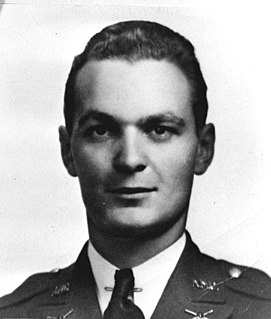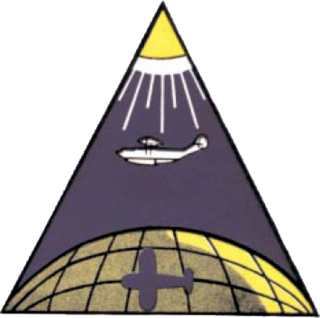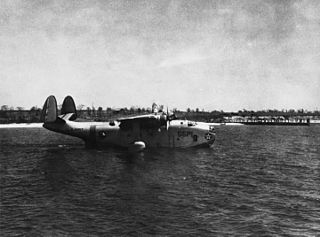
The Consolidated PBY Catalina is a flying boat and amphibious aircraft that was produced in the 1930s and 1940s. In Canadian service it was known as the Canso. It was one of the most widely used seaplanes of World War II. Catalinas served with every branch of the United States Armed Forces and in the air forces and navies of many other nations. The last military PBYs served until the 1980s. As of 2014, nearly 80 years after its first flight, the aircraft continues to fly as a waterbomber in aerial firefighting operations in some parts of the world. None remain in military service.

Ensign George Henry Gay Jr. was a Douglas TBD Devastator pilot in United States Navy Torpedo Squadron 8 operating from the aircraft carrier USS Hornet in the Pacific Theater of Operations during World War II. Of the 30 VT-8 aircrew from Hornet that participated in the pivotal Battle of Midway, Ensign Gay was the sole survivor.

Jack Mason Gougar was a full career aviator with the United States Navy. Beginning his career as an enlisted man, he earned his commission as a Mustang while participating in World War II.
Andrew Kenneth Waterman, enlisted in the United States Navy on 21 November 1932 at Buffalo, New York.

Robert George Tills was an officer and pilot of the United States Navy who became the first American naval officer killed during the Battle of the Philippines and had a ship named after him in his honor. His body was lost at sea during the battle and was recovered in November 2007 and officially identified in December 2008. He was buried at Arlington National Cemetery on 23 March 2009 with full military honors.
John W. Brock (1914–1942) was a United States Navy officer who received the Navy Cross posthumously for his actions in combat during World War II.

VP-102 was a Patrol Squadron of the U.S. Navy. It was established as VP-18 on 1 September 1937, redesignated as VP-13 on 1 July 1939, redesignated as VP-26 on 11 December 1939, redesignated as VP-102 on 16 December 1940 and disestablished on 18 April 1942.

VPB-63 was a Patrol Bombing Squadron of the U.S. Navy. The squadron was established as Patrol Squadron 63 (VP-63) on 19 September 1942, redesignated as Patrol Bombing Squadron 63 (VPB-63) on 1 October 1944 and disestablished on 2 July 1945.
VPB-92 was a Patrol Bombing Squadron of the U.S. Navy. The squadron was established as Patrol Squadron 92 (VP-92) on 26 December 1941, redesignated as Patrol Bombing Squadron 92 (VPB-91) on 1 October 1944 and disestablished on 28 May 1945. It operated the PBY-5A Catalina throughout its operational history.
VPB-29 was a Patrol Bombing Squadron of the U.S. Navy. The squadron was established as Pacific Air Detachment on 17 January 1923, redesignated Patrol Squadron 14 (VP-14) on 29 May 1924, redesignated Patrol Squadron 1-Naval District 14 (VP-1D14) on 21 September 1927, redesignated Patrol Squadron 1-B (VP-1B) on 1 July 1931, redesignated Patrol Squadron 1-F (VP-1F) on 15 April 1933, redesignated Patrol Squadron 1 (VP-1) on 1 October 1937, redesignated Patrol Squadron 21 (VP-21) on 1 July 1939, redesignated Patrol Squadron 1 (VP-1) on 30 July 1940, redesignated Patrol Squadron 101 (VP-101) on 3 December 1940, redesignated Patrol Bombing Squadron 29 (VPB-29) on 1 October 1944 and disestablished on 20 June 1945.
VP-3 was a Patrol Squadron of the U.S. Navy. The squadron was established as Patrol Squadron 16-F (VP-16F) on 2 January 1937, redesignated Patrol Squadron 16 (VP-16) on 1 October 1937, redesignated Patrol Squadron 41 (VP-41) on 1 July 1939, redesignated Bombing Squadron 136 (VB-136) on 1 March 1943, redesignated Patrol Bombing Squadron 136 (VPB-136) on 1 October 1944, redesignated Patrol Squadron 136 (VP-136) on 15 May 1946, redesignated Medium Patrol Squadron (landplane) 3 (VP-ML-3) on 15 November 1946, redesignated Patrol Squadron 3 (VP-3) on 1 September 1948, and was disestablished on 1 November 1955. It was the second squadron to be designated VP-3, the first VP-3 was redesignated VP-32 on 1 July 1939.

VP-22 was a Patrol Squadron of the U.S. Navy. The squadron was established as Patrol Squadron 4D-14 (VP-4D14) on 15 September 1928, redesignated Patrol Squadron 4-B (VP-4B) on 21 January 1931, redesignated Patrol Squadron 4-F (VP-4F) on 17 July 1933, redesignated Patrol Squadron 4 (VP-4) on 1 October 1937, redesignated Patrol Squadron 22 (VP-22) on 1 July 1939 and disestablished on 18 April 1942, with the squadron assets merged with VP-101.

VP-34 was a Patrol Squadron of the U.S. Navy. The squadron was established as Patrol Squadron 15-F (VP-15F) on 1 September 1936, redesignated Patrol Squadron 15 (VP-15) on 1 October 1937, redesignated Patrol Squadron 53 (VP-53) on 1 July 1939, redesignated Patrol Squadron 73 (VP-73) on 1 July 1941, redesignated Patrol Bombing Squadron 73 (VPB-73) on 1 October 1944, redesignated Patrol Squadron 73 (VP-73) on 15 May 1946, redesignated Amphibian Patrol Squadron 4 (VP-AM-4) on 15 November 1946, redesignated Patrol Squadron 34 on 1 September 1948 and disestablished on 30 June 1956.. It was the second squadron to be designated VP-34, the first VP-34 was redesignated VPB-34 on 1 October 1944.

VP-40 was a Patrol Squadron of the U.S. Navy. The squadron was established as Patrol Squadron 55 (VP-55) on 1 August 1940, redesignated Patrol Squadron 74 (VP-74) on 1 July 1941, redesignated Patrol Bombing Squadron 74 (VPB-74) on 1 October 1944, redesignated Patrol Squadron 74 (VP-74) on 15 May 1946, redesignated Medium Patrol Squadron (Seaplane) 10 (VP-MS-10) on 15 November 1946, redesignated Patrol Squadron 40 (VP-40) on 1 September 1948 and disestablished on 25 January 1950.
VPB-197 was a Patrol Bombing Squadron of the U.S. Navy. The squadron was established as Patrol Squadron 21 (VP-21) on 1 September 1938, redesignated Patrol Squadron 45 (VP-45) on 1 July 1939, redesignated Patrol Squadron 14 (VP-14) on 1 December 1939, redesignated Patrol Squadron 26 (VP-26) on 15 April 1941, redesignated Patrol Squadron 14 (VP-14) on 1 July 1941, redesignated Patrol Bombing Squadron 14 (VPB-14) on 1 October 1944, redesignated Patrol Bombing Squadron 197 (VPB-197) on 2 December 1944 and disestablished on 1 April 1946.

VPB-43 was a Patrol Bombing Squadron of the U.S. Navy. The squadron was established as Patrol Squadron 43 (VP-43) on 21 July 1941, redesignated Patrol Bombing Squadron 43 (VPB-43) on 1 October 1944 and disestablished on 15 September 1945.
VPB-44 was a Patrol Bombing Squadron of the U.S. Navy. The squadron was established as Patrol Squadron 44 (VP-44) on 3 June 1941, redesignated Patrol Bombing Squadron 44 (VPB-44) on 1 October 1944 and disestablished on 20 June 1945.

VPB-52 was a Patrol Bombing Squadron of the U.S. Navy. The squadron was established as Torpedo Squadron 3D15 (VT-3D15) on 12 July 1928, redesignated Patrol Squadron 3-S (VP-3S) on 21 January 1931, redesignated Patrol Squadron 3 Base Force (VP-3F) on 17 July 1933, redesignated Patrol Squadron 3 (VP-3) on 1 October 1937, redesignated Patrol Squadron 32 (VP-32) on 1 July 1939, redesignated Patrol Squadron 52 (VP-52) on 1 July 1941, redesignated Patrol Bombing Squadron 52 (VPB-52) on 1 October 1944 and disestablished on 7 April 1945.

VPB-125 was a Patrol Bombing Squadron of the U.S. Navy. The squadron was established as Patrol Squadron 20 (VP-20) on 1 September 1938, redesignated Patrol Squadron 44 (VP-44) on 1 July 1940, redesignated Patrol Squadron 61 (VP-61) on 6 January 1941, redesignated Patrol Squadron 82 (VP-82) on 1 July 1941, redesignated Bombing Squadron 125 (VB-125) on 1 March 1943, redesignated Patrol Bombing Squadron 125 (VPB-125) on 1 October 1944 and disestablished on 8 June 1945.











